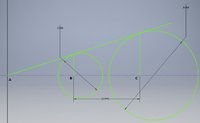Math gurus, I have a puzzler! Given the diagram below I need to determine the angle of A. The diameter of both circles are known (4 and 8) however the distance between the centers of the circles is not known. Both B and C are perpendicular to the dotted blue line and the distance between B and C are known. The distance between AB == BC due to the circle relationship being 1:2.
A little more to the story, this is to come up with a method to calibrate a laser measurement system. The dotted blue line is the axis of travel while the two circles are calibration disks. The green line adjacent to the blue is the laser itself (at an unknown angle) .The thought being the angle of A can be determined with the calibration disks and used as a static value to measure unknown disks.
I did try to do this using a single disk, the 4, however the error at 8 was too much (was just 0.02 however in this case it is too much). Thought is to use two disks at the min and max of the range to get a more accurate value.

A little more to the story, this is to come up with a method to calibrate a laser measurement system. The dotted blue line is the axis of travel while the two circles are calibration disks. The green line adjacent to the blue is the laser itself (at an unknown angle) .The thought being the angle of A can be determined with the calibration disks and used as a static value to measure unknown disks.
I did try to do this using a single disk, the 4, however the error at 8 was too much (was just 0.02 however in this case it is too much). Thought is to use two disks at the min and max of the range to get a more accurate value.


